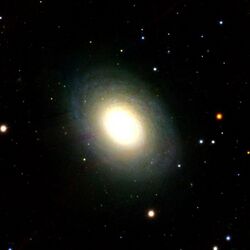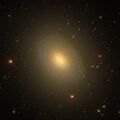Astronomy:NGC 4699
| NGC 4699 | |
|---|---|
 Image of NGC 4699 by PanSTARRS | |
| Observation data (J2000 epoch) | |
| Constellation | Virgo |
| Right ascension | 12h 49m 02.2s[1] |
| Declination | −08° 39′ 54″[1] |
| Redshift | 1394 ± 4 km/s[1] |
| Distance | 64 ± 24 Mly (19.7 ± 7.5 Mpc)[1] |
| Apparent magnitude (V) | 9.6 |
| Characteristics | |
| Type | SAB(rs)b [1] |
| Apparent size (V) | 3.8′ × 2.6′[1] |
| Other designations | |
| UGCA 301, MCG -01-33-013, PGC 43321[1] | |
NGC 4699 is an intermediate spiral galaxy located in the constellation Virgo. It is located at a distance of about 65 million light years from Earth, which, given its apparent dimensions, means that NGC 4699 is about 85,000 light years across. It was discovered by William Herschel in 1786. It is a member of the NGC 4699 Group of galaxies, which is a member of the Virgo II Groups, a series of galaxies and galaxy clusters strung out from the southern edge of the Virgo Supercluster.[2]
Characteristics
NGC 4699 is a Seyfert like galaxy with very weak nuclear emission.[3] The galaxy features a bar that is 0.41 arcminutes long and a ring with diameter 1.95 arcminutes.[4] The galaxy features a large bulge which accounts for the 11.3% of the stellar mass of the galaxy and a large disky pseudobulge, which is larger than the strong bar. The disk within the bulge features tightly wrapped spiral arms.[5] There are a lot of HII regions in the disk.[3] The galaxy has an extended type-III outer disk,[6] with low central surface magnitude and which is thicker than the inner disk.[7]
Supernovae
Two supernovae have been observed in NGC 4699, SN 1948A and SN 1983K. SN 1983K was a type II supernova with plateau-shaped light curve. The spectra of the supernova featured a progressive violet swift, which was explained by the presence of a proexisting outer shell of materials around the progenitor of the supernova.[8]
Nearby galaxies
NGC 4699 belongs in the NGC 4697 group according to Makarov and Karachentsev. Other members of the group include NGC 4697, NGC 4674, NGC 4700, NGC 4731, NGC 4742, NGC 4775, NGC 4781, NGC 4784, NGC 4790, NGC 4813, NGC 4948 and NGC 4958.[9] It belongs to the Virgo II groups, an extension of the Virgo Cluster.[10]
Gallery
NGC 4699 by the Sloan Digital Sky Survey
References
- ↑ 1.0 1.1 1.2 1.3 1.4 1.5 1.6 "NASA/IPAC Extragalactic Database". Results for NGC 4699. http://ned.ipac.caltech.edu/cgi-bin/nph-objsearch?objname=NGC+4699.
- ↑ "The Virgo III Groups". Atlas of the Universe. http://www.atlasoftheuniverse.com/galgrps/viriii.html.
- ↑ 3.0 3.1 Gonzalez Delgado, Rosa M.; Perez, Enrique; Tadhunter, Clive; Vilchez, Jose M.; Rodriguez-Espinosa, Jose Miguel (January 1997). "Hii Region Population in a Sample of Nearby Galaxies with Nuclear Activity. I. Data and General Results". The Astrophysical Journal Supplement Series 108 (1): 155–198. doi:10.1086/312951. Bibcode: 1997ApJS..108..155G.
- ↑ Comerón, S.; Salo, H.; Laurikainen, E.; Knapen, J. H.; Buta, R. J.; Herrera-Endoqui, M.; Laine, J.; Holwerda, B. W. et al. (19 February 2014). "ARRAKIS: atlas of resonance rings as known in the S4G". Astronomy & Astrophysics 562: A121. doi:10.1051/0004-6361/201321633. Bibcode: 2014A&A...562A.121C.
- ↑ Erwin, P.; Saglia, R. P.; Fabricius, M.; Thomas, J.; Nowak, N.; Rusli, S.; Bender, R.; Vega Beltran, J. C. et al. (10 December 2014). "Composite bulges: the coexistence of classical bulges and discy pseudo-bulges in S0 and spiral galaxies". Monthly Notices of the Royal Astronomical Society 446 (4): 4039–4077. doi:10.1093/mnras/stu2376. Bibcode: 2015MNRAS.446.4039E.
- ↑ Erwin, Peter; Pohlen, Michael; Beckman, John E. (2008). "The Outer Disks of Early-Type Galaxies. I. Surface-Brightness Profiles of Barred Galaxies" (in en). The Astronomical Journal 135 (1): 20–54. doi:10.1088/0004-6256/135/1/20. ISSN 1538-3881. Bibcode: 2008AJ....135...20E.
- ↑ Chudakova, E. M.; Sil'chenko, O. K. (11 May 2014). "The thickness of stellar disks in early-type galaxies". Astronomy Reports 58 (5): 281–290. doi:10.1134/S1063772914050023. Bibcode: 2014ARep...58..281C.
- ↑ Grasberg, Eh. K. (1 May 1993). "Features of the outburst of the supernova SN 1983K in NGC 4699". Astronomy Letters 19: 153–159. ISSN 1063-7737. Bibcode: 1993AstL...19..153G. http://adsabs.harvard.edu/cgi-bin/bib_query?1993PAZh...19..401G. Retrieved 23 July 2017.
- ↑ Makarov, Dmitry; Karachentsev, Igor (21 April 2011). "Galaxy groups and clouds in the local (z~ 0.01) Universe". Monthly Notices of the Royal Astronomical Society 412 (4): 2498–2520. doi:10.1111/j.1365-2966.2010.18071.x. Bibcode: 2011MNRAS.412.2498M. http://www.sao.ru/hq/dim/groups/galaxies.dat. Retrieved 23 July 2017.
- ↑ "The Virgo II Groups". http://www.atlasoftheuniverse.com/galgrps/virii.html.
External links
- NGC 4699 on WikiSky: DSS2, SDSS, GALEX, IRAS, Hydrogen α, X-Ray, Astrophoto, Sky Map, Articles and images
 |


